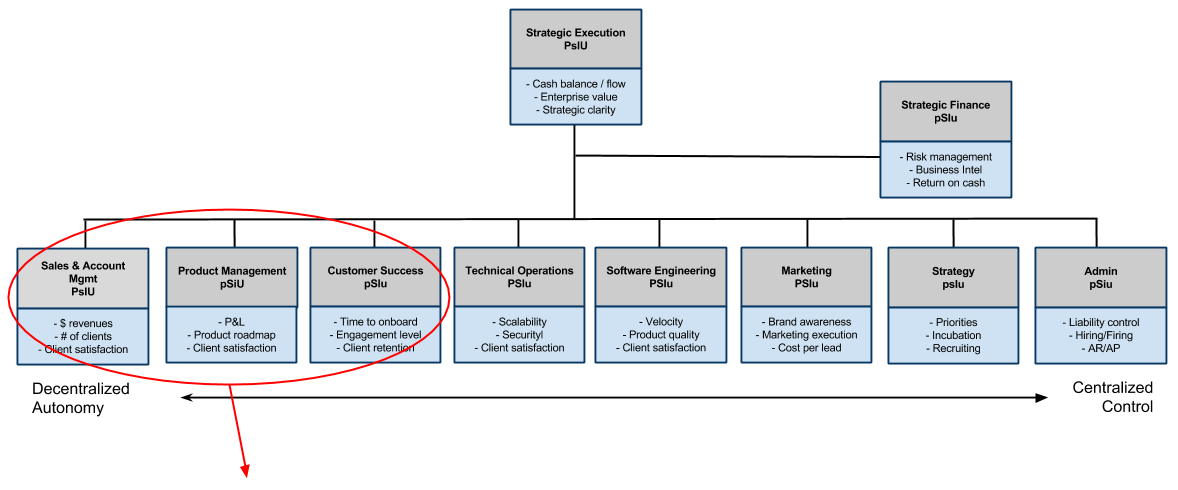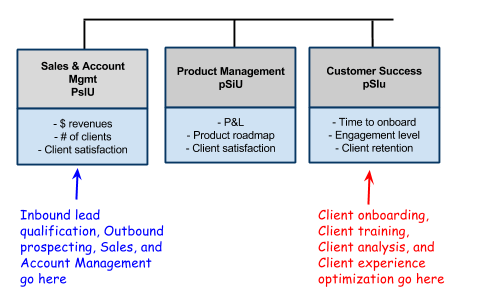If You Want Something to Improve In Your Org, Create a Role Accountable for It
Summary Insight:
If you treat Customer Success like Account Management, you’re setting fire to scale. This article shows how to structure for growth by separating roles, styles, and time horizons.
Key Takeaways:
- Account Management is a relationship role focused on key accounts and short-term revenue.
- Customer Success is a systems role focused on all accounts, onboarding, and product adoption.
- Segmentation of roles across the business drives clarity, accountability, and execution speed.

“We believe that the future standard for all executive teams will include a head of Customer Success who’s on the same level as the head of Sales, Marketing, and Demand Generation.” – Aaron Ross
If you run a software-as-a-service (SAAS) business, you might already know about the core concepts behind Aaron Ross and Margaret Tyler’s book Predictable Revenue. Aaron Ross learned his craft as the head of customer acquisition for Salesforce.com and this book seems to have become the hot new bible for scaling up the revenue side of a SAAS business.
The main theme of Predictable Revenue is that the single most important thing a SAAS business can do to scale revenues is to segment its Sales roles into distinct focus areas and also to create a new role in the organizational structure called “Customer Success” that is dedicated to making existing customers successful and driving renewals.
Lately, I’ve been getting asked frequently in my consulting practice about how to structure the Customer Success role. My sense is that there is some confusion out there about the distinction between Account Management and Customer Success. In this article, I’m going to show you how to use the principles of Organizational Physics to actually structure the Customer Success role so that your own SAAS business has the greatest probability of realizing its potential.
Role Segmentation: Always a Good Idea
Predictable Revenue argues that the major role of Sales is actually four roles that need to be segmented in the organizational structure:
- “Inbound Lead Qualification” to qualify new leads coming into the business;
- “Outbound Prospecting” to create and qualify new sales opportunities and then pass them to Sales or Account Executives to close;
- “Account Executives or Sales” that close deals and carry a quota;
- “Account Management/Customer Success” which is a role dedicated to making existing customers successful and driving renewals.
Does it make sense to segment these different sales roles? Absolutely. In fact, you should define and segment all of the major roles and most of the minor roles in your entire business — not just sales.
Segmenting by roles greatly supports scaling your business. It helps to create role clarity and accountability. It allows the right style of people to focus on the most important things for their roles. It significantly improves the hiring process. And with the right management process, it can significantly increase execution speed.
Predictable Revenue encourages the segmentation of sales roles earlier than one might think and I totally concur — but again, for all roles. Technically I would start to think through your organizational design and role segmentations in the mid- to late Nail It stage of business development. Heck, it doesn’t even cost anything to segment by roles if you don’t have the budget to hire for it. Some of your staff can wear multiple hats until you do.
So how should you actually structure the four specialized roles defined by Predictable Revenue? The first three are easy. Outbound Reps, Inbound Lead Qualifiers, and Account Executives/Sales should go under the head of Sales. This makes sense intuitively. All three of these roles are about being effective in the short term and building and managing revenue-driving relationships. They also benefit from being under a single head of Sales.
But what about the fourth role of Account Management/Customer Success? This is the role that’s creating all the buzz (and I think some confusion) — how do you actually structure that? Here is where I differ from Ross and Tyler. From my experience, Account Management and Customer Success should not be thought of as one but as two distinct roles. If you structure with this in mind, you’ll have a much easier time filling both roles and getting to scale.
Account Management & Customer Success are not the Same Role
Below are two pictures of a simple business-to-business SAAS structure. They are meant to illustrate how a scalable organizational design will keep Account Management under Sales and treat Customer Success as its own major function.
This organizational design is based on the 5 Laws of Structure in Organizational Physics and places the major functions of the business in their correct relative locations based on the competing needs of short-/long- range view, efficiency/effectiveness, and autonomy/control.
The first picture shows the ten major functions of this business in grey: Strategic Execution, Strategic Finance, Sales and Account Management, Product Management, Customer Success, Technical Operations, Software Engineering, Marketing, Strategy, and Admin. (Every structure is unique, but these are some basic major functions you would typically find in a B2B SAAS company.)
The second picture just zooms in on the Sales & Account Management, Product Management, and Customer Success roles:


Before I proceed, I want to remind you that an organizational structure is not the same as an org chart. What this picture above is showing you is that this SAAS business has ten major functions. Each function has a PSIU code and a set of key performance indicators (KPIs) in blue. If you are unfamiliar with the PSIU code, it’s really helpful in designing your own organization to scale and making smarter hires. You can learn more about the PSIU framework here. It should also be clear that I am not designing for silos, but for unarguable accountability and cross-functional transparency.
Keep Account Management Under Sales & Make Customer Success its Own Major Function
OK, so why have I placed Account Management under Sales and not created a joint Account Management/Customer Success role as originally proposed by Predictable Revenue? The answer is that Account Management is a revenue-driving relationship role and Customer Success is a revenue-driving systems role. You will create more clarity, focus, and role fit and scale more easily by keeping these roles separate.
It seems to me that the authors of Predictable Revenue understand these differences intuitively. Even though they define Account Management/Customer Success as one function, note the subtle but important differences in their own definitions taken from their blog:
“Account Management/Customer Success: Account Management usually implies a quota-carrying salesperson working with current customers. Customer Success implies someone without a quota (that is, unbiased) whose job is solely to help customers get more value from your product, whether through hands-on help, education and training, etc.”
If you can conceptualize Account Management and Customer Success as two distinct roles rather than one, it suddenly gets pretty easy to figure out how to structure them both.
You’ll want a single head of Sales and Account Management overseeing Inbound Lead Qualification, Outbound Prospecting and Account Executives/Sales, as well as Account Management. Specifically what I mean by Account Management is Key or Strategic Account Management focused on building relationships, being the voice of key customer needs, and driving recurring and upsell revenues from your largest and most important accounts.
If your business does not have customer tiers, then you won’t even need the Account Management role – and note that neither Key Account Management nor Customer Success are the same thing as Customer Service. Customer Service is the role that provides low-level user support at an affordable cost. Account Management and Customer Success, on the other hand, are revenue-driving roles.
In addition to the head of Sales and Account Management, you’ll also want a head of Customer Success that oversees Client Onboarding, Client Training, Client Analysis, and Client Experience Optimization. Notice that all of these sub-roles require a systems approach. They need analysis. They need to be the voice of all customers, not just the largest ones. They also need to drive revenue by ensuring that all clients are activating the product, understanding and using it, and finding insights in usage analytics that help drive overall product improvements that increase usage and renewals.
3 Breakdowns that Happen When You Combine Account Management & Customer Success
There are 3 major types of breakdown that occur when you combine Account Management and Customer Success into a single role. They are breakdowns in focus, style, and time horizon.
Breakdown in Focus
Think about it. The entire ‘Customer Success’ movement was born from Ross’ and others’ recognition of a simple fact: Companies without a function focused on engagement and renewals from existing clients fail to scale because they focus too heavily on making new sales. It’s a classic symptom of trying to Scale It before Nailing It.
On the other hand, companies that combine Customer Success and Account Management, end up with similar problems, sacrificing the product experience of the many accounts (Customer Success) for the needs of the few key accounts (Account Management). Account Management ends up overpowering Customer Success or vice versa.
Again, the Account Management role is a relationship role that needs to focus on the needs, aspirations, and renewals of key accounts. Customer Success is a systems role that needs to focus on the needs, aspirations, and renewals of all accounts. Keep them separate and put the right focus, leadership style, and KPIs in each area.
Breakdown in Styles
The PSIU style and approach of a world-class Key Account Manager requires a high drive to Unify or create rapport and connect with key accounts. While we’re looking for a high drive to Produce and win new accounts from the other sales roles, we want a more Unifying approach from Account Managers who build relationships and create empathy with important clients.
You can contrast the style of a great Account Manager with the style and approach of a world-class Customer Success leader, who should demonstrate a high drive to Stabilize and Innovate, but not to Unify. The Customer Success leader excels at designing systems, analyzing data, finding efficiencies and, generally, making the entire system work better at scale.
If you were to place an Account Manager type with a high Unifier style into the Customer Success role, then you would get a lot of great customer interactions but not a lot of scalability, design insights, or process improvements. Customer Success must design and optimize systems and processes to onboard new clients, train all clients elegantly so they understand and engage with the product, and optimize the overall client experience for all clients.
In short, always try to put the right style of people into roles where they and the business can thrive.
Breakdown in Time Horizon
In addition to a breakdown in focus and styles, there is also a different time horizon for Account Management versus Customer Success. Account Management will always be under tremendous short-range pressure to meet key account needs and drive new revenues from their portfolio of accounts. It’s about relationships – and the needs of the most pressing and important relationship should always take precedence.
Customer Success is going to be under a lot of short-range time pressure too but you want to design the organization so that Customer Success doesn’t collapse under this short-range pressure. Customer Success must keep a medium-range time orientation (e.g., the next 3 to 6 months, not the next 3 to 6 weeks). If not, then it will start acting more like an Account Manager being whip-sawed by the needs of key accounts and less like the head of Customer Success for all accounts.
If you take another look at the structure diagram above, you will see that Product Management is situated between Sales/Account Management and Customer Success. This is not arbitrarily so. Product Management mediates between the two functions. The purpose of Product Management is to translate, prioritize, and coordinate the competing needs, focus, and time frames that are occurring between Sales/Account Management and Customer Success (as well as the competing priorities coming from Strategy, Marketing, and elsewhere).
We want Account Management to put pressure on the company to fulfill on the needs of key accounts. We also want Customer Success to put a different pressure on the company for the needs of the overall product experience and for renewals. The role of Product Management is to to make the hard decisions that balance out those competing needs and move the business forward now and over time. If you’re interested, you can read more about the Product Management role here.
Summary
Predictable Revenue has started a broad and productive conversation that is still evolving.
Despite how it’s been defined by Predictable Revenue, I believe that Customer Success should not be placed in the same category as Account Management. While every structure is unique, it generally makes more sense to keep Account Management under Sales and make Customer Success into its own major function.
Additionally, I think that one of the important ideas in this book – role segmentation – should apply not only to Sales but to all the major and minor roles in your business.
Finally, the idea of having happy, recurring customers is obviously not new and it involves more than formalizing a Customer Success role. It’s always a total company effort that requires constant engagement, effort, and reinforcement from all roles in the company.




